Learn
- Intro to Greek Theatre
- Parts of the Theatre
- Performing for Dionysus
- Parts of a Greek Play
- Greek Plays that Exist Today
Intro to Greek Theatre
Much of what we consider today as theatre has its beginnings in the theatre world of ancient Greece. But, how did it get its start?
Greek theatre was part of the worship of the Greek God Dionysus, the Greek god of wine and the grape harvest. To understand how this worked, we must first look at the structure of a Greek theatre. Read the following, focusing on the four parts of the theatre and the purposes of each:
- Greek Theaters, from Reed College
- Greek Theatre Architecture from The Ancient History Encyclopedia

The Ancient Theatre of Taormina on the island of Sicily, Italy was built in the third century BC. You can see Mount Etna, which is an active volcano, in the distance. See a larger version of the Greek theatre here.
Parts of the Theatre
After reading the articles in the previous tab, check your understanding of the parts of the Greek theatre by reviewing the information below:
Orchestra
The orchestra was the part of the theatre where the action of the play takes place.
- The orchestra also included the thymele, or the altar to Dionysus, which was placed in the middle of the orchestra.
- During the ceremonies honoring Dionysus, the chorus (or a group of chanters) would dance around the altar and a goat would be sacrificed.
- The chorus was often referred to as goat singers and their songs called tragos, or goat-songs. The word tragedy was developed from this word tragos and another Greek work oide meaning "song."
- The chorus was an important part of Greek theatre. They were used to explain a situation and often interacted with the actors and the audience.
- Legend has it that Thespis, the first actor, stepped out from the chorus to stand alone, which is why actors are referred to as thespians today.
More Parts: Parados and Theatron
The parados, or the two entrances for the chorus, allowed the chorus to take an active role in the performance.
The theatron, which means "the seeing place," was located on either side of the orchestra and is where the audience would sit to watch the action of the play.
- It is believed that some ancient Greek theatron could seat as many at 17,000 people. Thaat is more than 3 times the number of people that can sit in Madison Square Garden in New York City!
- The word we use today to refer to the place where we go to see play (theatre) is derived from the Greek theatron.
Skene and Deus ex Machina
The skene, or dressing room, was used for the actors to change costumes and masks.
- At first, the skene was merely a tent, but later turned into a stone building.
- Once the skene became so permanent, it was used as part of the performance. Scenery was often painted on the front and actors portraying the gods would perform on the roof as if on Mount Olympus.
- A machine was developed and used to lower the actors from the roof of the skene to the ground. This was used to demonstrate a god leaving Mount Olympus and coming to Earth to resolve a problem.
- This practice developed into a common action in theatre, and even it's part of TV, film, and plays today! It's called deus ex machina, which literally translates to "god from machine". (Hear how to pronounce deus ex machina here.)
- In ancient plays, it referred to a god literally came down to Earth from Mount Olympus (using a machine to get from the top of the skene to the floor of the orchestra) to resolve an issue in the play.
- However, in today's plays, it refers to a person, thing, or event that occurs suddenly and unexpectedly but provides a solution to a difficult problem or situation. For example, if a playwright is having trouble resolving a plot, he or she may use an outside force, like a letter from a long lost relative, to resolve this problem in the play.
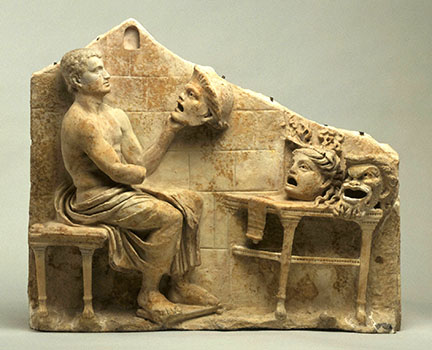
This relief of a seated poet (Menander, a Greek dramatist) with masks of Athenian New Comedy dates between the 1st century B.C. and the early 1st century A.D. | Public domain. See larger version of relief at the Princeton University Art Museum.
Performing for Dionysus
Now that you have an understanding of what a Greek theatre looked like, let's look more deeply at the plays that would have been performed during the Dionysian Festival (also called the City Dionysia, or the Great Dionysia), the annual festival honoring the Greek god, Dionysis. These festivals would last five or six days and involved contests for playwrights and theatrical performances.
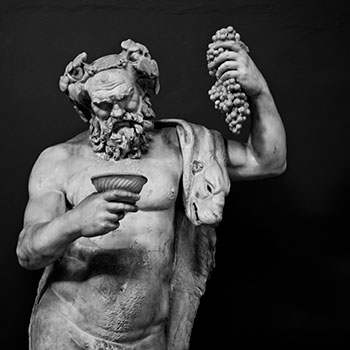
A statue of Dionysus in The Vatican Museum's collection in Rome, Italy. Image by Derek Key is licensed under CC BY 2.0.
Playwrights would write four plays and submit them to a archon, or the governor of the festival. Three of the plays were tragedies and would form a trilogy, which consists of three plays related by theme, myth, or characters.
The fourth play would be a satyr play, which was a play that combined elements of tragedy and comedy into one; satyr plays were often rude and vulgar in nature. The archon would decide which playwrights would participate in the festival.
Once a playwright was accepted, the archon would appoint a choregoi, who was a wealthy citizen responsible for financing the preparations for the chorus. This was an important responsibility that was seen as an honor by the person selected! The choregoi paid for props, costumes, scenery, and the salary of the chorus members; it's a role equivalent to today's producers.
The winner of the competition would win a laurel wreath, or a wreath made of interlocking branches of bay laurel, and placed on the head of the winner.
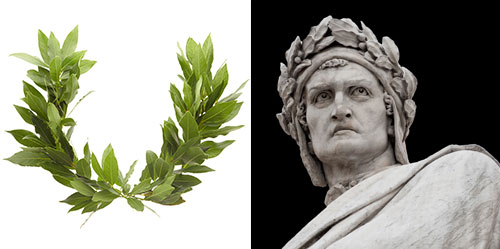
Left: a laurel wreath; Right: A statue of Dante Alighieri (a Medieval Italian poet) wearing a laurel wreath in the tradition of ancient Greece.
Parts of a Greek Play
A Greek play was made up of five separate parts.
- A play began with the prologue, which is the introduction that provided any background necessary for the audience to understand the play.
- After the play was introduced, the chorus would enter singing a song called the parados. You will remember that this is also the term used to refer to the area of the theatre where the chorus made their entrances and exits. That isn't a coincidence!
- Following the parados, episodes (or events that are part of the dramatic sequence) would occur to advance the plot.
- The episodes are the events that make up the larger story that is being told, like scenes in today's plays.
- At times, different episodes would take place in different locations. In order to communicate this change, periaktoi would be used; periaktoi are triangular prisms with different scenes painted on each side. The periaktoi could be turned to create scenery for three different locations. We have recently seen these make a reappearance in theatres as a cheap way to put together multiple sets.
- Also used to help denote different locations for different scenes were pinakes, or painted panels placed in the openings of the skene. Because these were temporary, they could be changed as the play moved from location to location.
- Following each episode in a tragedy, the chorus would perform a stasimon, or an ode used to reflect on what occurred in the prior episode.
- These would also help to place the events in the context of the religious story that was being told. Remember that these plays were part of a religious festival!
- In a comedy, however, the parabas would occur between the episodes; in a parabas, actors leave the stage and the chorus addresses the audience directly. Often a parabasis had nothing to do with the story being told. It could be a reflection on the career and talent of the playwright!
- The final piece of a Greek play was the exodus, when the chorus sung their final song upon exiting.
- This song would put the story in the framework of what the audience should have learned from watching the play.
- The hope was for the audience to feel pathos, or pity, for what the characters had experienced during the play.
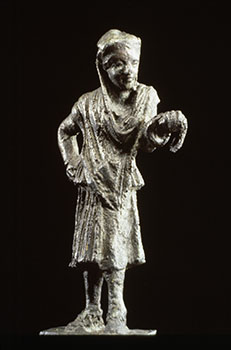
A bronze statue of an actor dating from circa 150 and circa 100 B.C. We know it's an actor from the half-mask over the eyes and nose of the figure. He wears a man's conical cap but female garments, which follows the Greek custom of men playing the roles of women in theatre. See a larger version of this statue at the Walters Art Museum | Public domain
Greek Plays that Exist Today
Of the hundreds of Greek tragedies written, only some full length texts by three playwrights have survived. Conversely, what we know about Greek comedy comes in the 11 surviving plays of Aristophanes.
Four Ancient Playwrights
While there were many playwrights that submitted plays to the Dionysian Festivals, most records of their efforts have been lost. Those we do know about were the most celebrated, both in creating award-winning tragic and comic works of theater, but also in their contribution to shaping the conventions of the genre.
Aeschylus (525-455 BCE) was a prolific playwright, credited for over 80 plays (though just handful have survived). He was also extremely successful, winning top festival honors more than a dozen times. The three tragedies in his trilogy, Orestia, deal with the concept of vengeance vs. justice and breaking the cycle of violence. Aeschylus was also an actor, and helped advance the development of scenery and costuming through his plays.
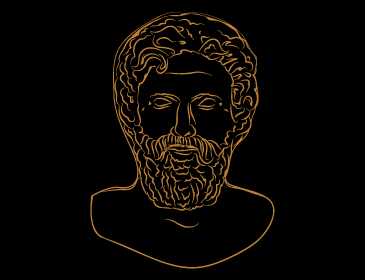
Originally, Sophocles (496-406 BCE) was an actor, but due to a weak voice, he gave it up and instead became the first poet to exclusively write, rather than perform, his own plays. The plays of Sophocles were frequent festival winners, popular with judges and audiences alike. The Greek philosopher Aristotle credits Sophocles for increasing the number of actors from two to three and the chorus to thirteen. Antigone, Electra, and Oedipus Rex are among Sophocles' most famous tragedies.
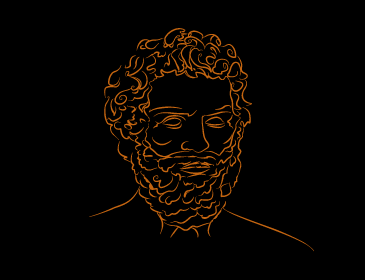
While Euripides (480-407 BCE) was just as prolific as Aeschylus and Sophocles, he did not enjoy the same level of success in his lifetime, as he inserted more social commentary than was usual in his plays. In his tragedy Medea, Euripides created one of the first strong female main characters, driven to misguided vengeance by her fury, rather than by fate. Fortunately, a larger number of his plays — 18 tragedies and one satyr play - survived, and his work became popular in the second century.
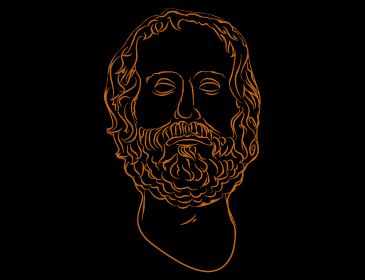
The plays of Aristophanes (ca 450-385 BCE) helped define Old Comedy, where unlike tragedy, the chorus and actors interact directly with the audience. Also unlike the tragedians, whose plays often focused on historical events played out within the context of myths and legends, Aristophanes' plays satirized contemporary subjects, with caricatures of real people, including Euripides, Sophocles and Aeschylus. Of his more than 40 plays (11 of which survive), he only received six festival victories. His 405 BCE play, The Frogs, an episodic "buddy comedy" about travelling through Hades, was so well-received it won an unprecedented second performance in the next year's festival.
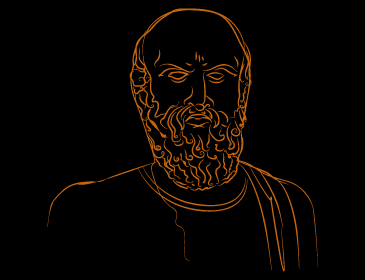
Plays
Now that you've read about the four most well-known playwrights, let's take a look at some of their plays! Read You Gotta Know These Ancient Greek Plays from NAQT for a brief introduction to few of them.
- Are there any that you have heard of?
- Any that you would be interested in seeing?
As you can see in this lesson, there are many characteristics of Greek theatre that have carried into theatre today!
Source: Information (Four Ancient Playwrights from City Dionysia: The Ancient Roots of Modern Theatre, The World of Greek Arts) has been reproduced above, courtesy of The Kennedy Center, Arts Edge.

